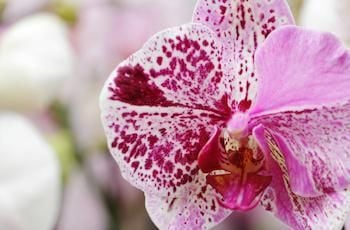
Just like humans, every Phalaenopsis orchid is different. Though they may not have the personality differences of humans, orchids can present you with a variety of growth and care situations.
You might find that one orchid was simple to care for, while another was susceptible to pests. Or you might be wondering why a certain care routine worked well for an orchid, while the same routine resulted in the decline of another orchid.
Whether this is your 10th orchid or your first, you might have questions on how to keep your plant flourishing. To answer your most pressing queries, we consulted with our expert growers. Here are the answers to five of the most frequently asked Phalaenopsis orchid care questions.
Sunburn just doesn’t affect humans—orchids can be vulnerable to the effects of the sun’s rays, too.
Sunburned orchid leaves start out with a yellow spot, and eventually, the spot will turn white. There’s not much that can be done when a leaf has suffered sunburn, but you can check the color of your orchid’s roots to make sure it hasn’t become dehydrated as a result.
Healthy, well-watered roots will be plump and green, but roots that need more water will appear white or gray. If you notice your orchid’s roots could use more water, either increase the watering frequency or amount until you notice the roots have turned green again.
Although your orchid may look like it’s uncomfortable in its pot, wait to repot it until it’s done blooming. Repotting is stressful to the plant; combined with any damage it may have sustained during the fall, your orchid could become even more damaged.
If your plant’s still blooming, place some sphagnum moss on the exposed roots to add coverage and moisture. The roots need moisture if they appear white or gray.
After it has bloomed, you should fertilize your orchid every month with a fertilizer balanced at 20-20-20 and diluted to half the strength. You shouldn’t make fertilizer cubes because a pet or child may ingest them, and be sure to store the fertilizer in a cool, dark place away from pets or children.
You can use one even though the grow light isn’t as strong as sunlight. Just be sure to supplement it with sunlight, and don’t keep the grow light on the orchid all day. Also, check your plant’s leaves to make sure it’s not receiving too much light. Healthy leaves will be strong and are a medium to light shade of green.
Once the last bloom has fallen off, an orchid’s resting phase typically lasts between six to nine months, but can vary from plant to plant. During this phase, you may notice your plant grows a new leaf, which is needed before a new flowering spike can be produced. Don’t forget to continue watering and fertilizing your orchid during this period.

Copyright Just Add Ice® Orchids 2023